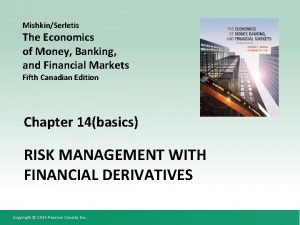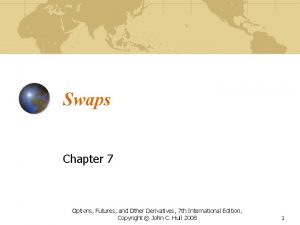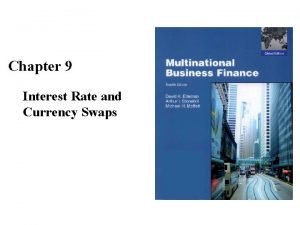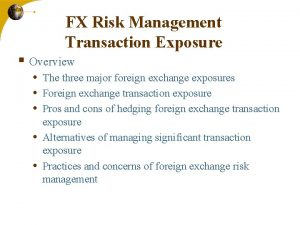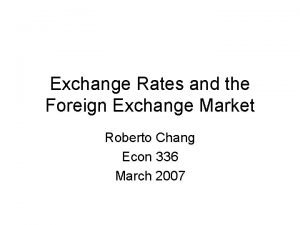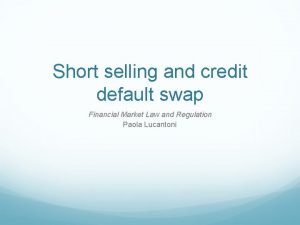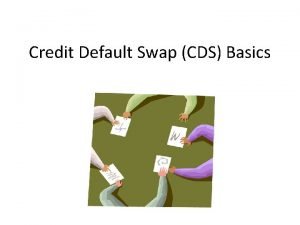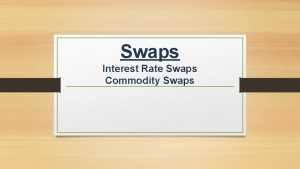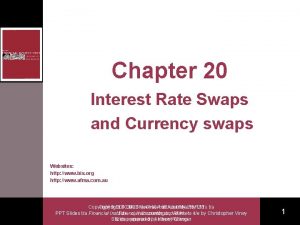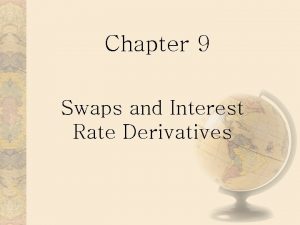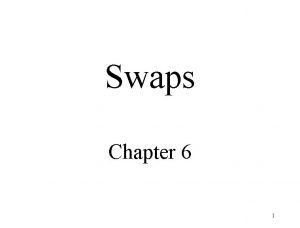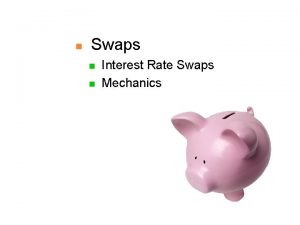Lecture 10 Derivatives III Currency interest rate swaps






![Summary of the Lecture q Main subject: swap agreements: [currency or interest rate] q Summary of the Lecture q Main subject: swap agreements: [currency or interest rate] q](https://slidetodoc.com/presentation_image_h/1e58b6b84c9b19568719988bb38b172a/image-7.jpg)


- Slides: 9

Lecture 10: Derivatives III Currency & interest rate swaps Galina A Schwartz Department of Finance University of Michigan Business School Finance 614: Lecture notes 1

Plan of today’s lecture n n Midterm follow-up Levich, Chapter 13 q Swaps are derivative securities redundant securities q Main types of swap agreements q Why do we have them? [who could gain from them] q What drives the demand for swaps? Finance 614: Lecture notes 2

Players & Terminology n n Players: Industry & Financial Companies, Re [ – `The Usual suspects`] What drives the demand for swaps? Capital controls q Transaction costs q Differences in parties’ comparative advantage [Market segmentation & asymmetric information] q n Terms [Jargon]: q q Plain vanilla swaps Exotic swaps Finance 614: Lecture notes 3

Swaps: market characteristics q Main types of swap agreements currency or interest rate q fixed-rate or q floating rate or q fixed-floating interest rate swaps q q Why do we have them? [who could gain from using them] To hedge [hedgers] [reducing risks] q To speculate [speculators] [capturing. Finance arbitrage opportunities] 614: Lecture notes q 4

Pricing the Swaps q How do we price them? q Net present value approach q Through calculating the expected discounted cash flow q Swap associated risks: q. Asymmetric q. Time varying Finance 614: Lecture notes 5

Regulatory requirements n Bank for International Settlements (BIS) imposed capital requirements – A major development! n BIS capital requirements: q Advantageous: q Simple and easy to implement q Transparent q Drawbacks [disadvantages]: q. No fine tuning qregulatory costs Finance 614: Lecture notes 6
![Summary of the Lecture q Main subject swap agreements currency or interest rate q Summary of the Lecture q Main subject: swap agreements: [currency or interest rate] q](https://slidetodoc.com/presentation_image_h/1e58b6b84c9b19568719988bb38b172a/image-7.jpg)
Summary of the Lecture q Main subject: swap agreements: [currency or interest rate] q Swaps are used for: Cheap [& Quick] currency and interest rate risks management Why do we have them? q Who uses them? q How do we price them? q Finance 614: Lecture notes 7

What is next (Lecture 11): n A follow-up of Prof. Honeyman’s lecture: q International financial markets adjustment to the coming technical innovations: q Market power & efficiency scale: up or down? q Efficiency: market completeness & pricing mechanisms Finance 614: Lecture notes 8

What is next (continued) Generalized transaction costs up or down? [Generalized transaction costs: -- overhead (par example infrastructure related) costs -- the costs resulting from the risk of default [direct and indirect (such as legal)]] q Globalization: standard versus segmentation q Scope for government intervention up or down? q Finance 614: Lecture notes 9
